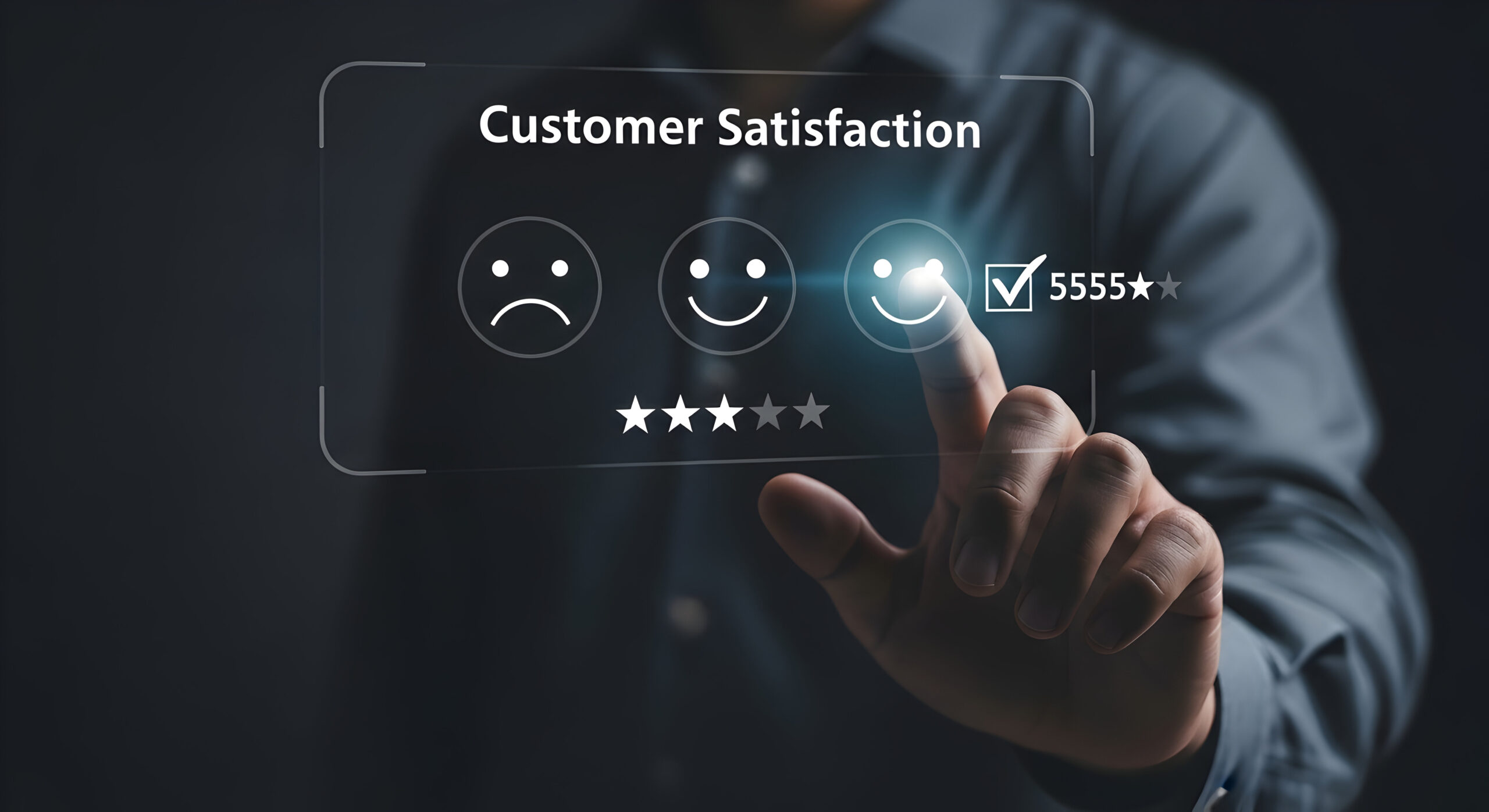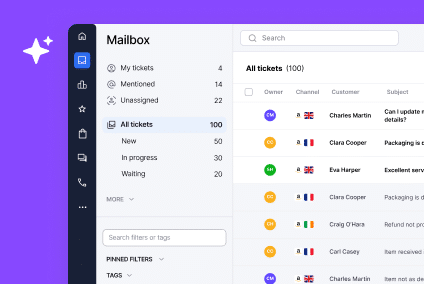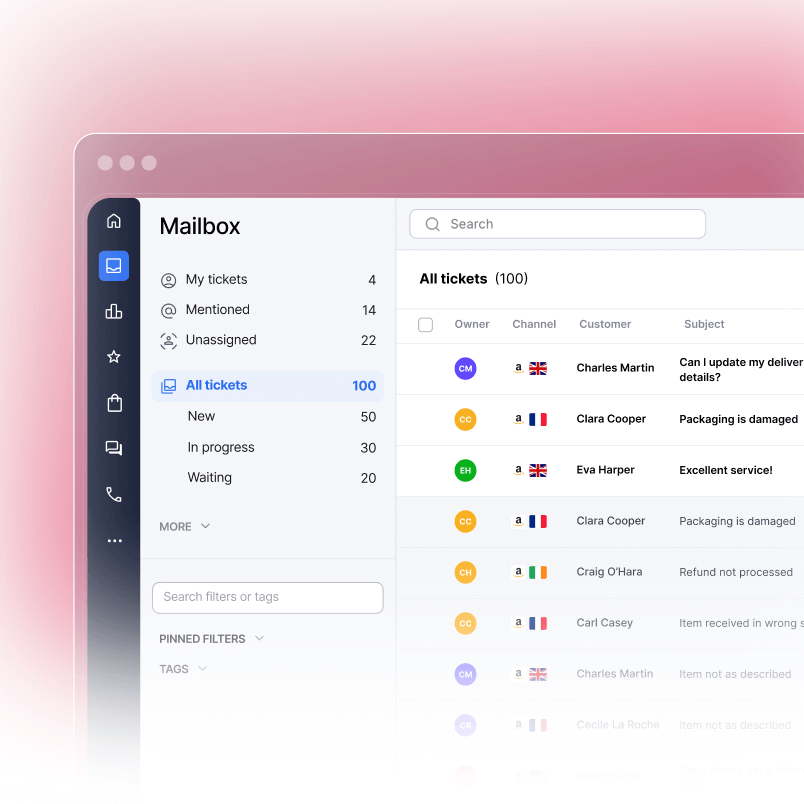Your customer service team generates data every single day. Ticket times, satisfaction scores, resolution rates. But which metrics move the needle on revenue, retention, and real customer loyalty?
We’ve tracked hundreds of support teams, and the truth is simple: not all metrics are created equal. Most companies waste time chasing vanity numbers that look good in dashboards but don’t predict outcomes. 90% of customers expect immediate responses to inquiries, and 85% of decision-makers expect customer service to contribute a larger share of revenue. This guide breaks down 15 customer service metrics that directly connect to your bottom line, with formulas, benchmarks, and a clear explanation of why each one matters.
If you’re managing customer support for an eCommerce store, SaaS platform, or any business where retention drives revenue, this is the data to track.
Why Metrics Matter in Customer Service
Your support team doesn’t just solve problems. They build relationships, prevent churn, and create reasons for customers to stay. 52% of consumers have switched to other providers due to poor customer service, and customer-obsessed organizations report 41% faster revenue growth and 49% faster profit growth.
But here’s where most companies go wrong: they track activity instead of impact. A 2-hour average response time sounds good until you realize it has no relationship to customer lifetime value. A high ticket volume might mean your team is busy, or it might mean customers are frustrated and submitting multiple tickets.
The metrics that matter are the ones that connect directly to three core business outcomes.
First, customer retention. When customers feel heard and their issues resolve quickly, they stay. This cuts acquisition costs and increases lifetime value. Organizations that score high on CSAT enjoy 2.5 times better revenue growth than those that score low.
Second, revenue expansion. Good support reduces churn, but great support drives upsells. A customer who had a positive support experience is more likely to upgrade, renew, or buy additional products. Companies investing in customer experience see an ROI of 7.5x, proving that support quality directly impacts the bottom line.
Third, operational efficiency. You need to know if your team is working effectively. A high cost per ticket combined with low satisfaction means you’re burning money on support that doesn’t stick. Call centers experience turnover rates as high as 44% annually, often driven by inefficient workflows and unclear metrics. 86% of agents report that customer expectations are higher than ever, making it critical to measure what actually drives retention and revenue.
The metrics in this guide are divided into two categories: operational metrics (how your team is performing day to day) and strategic metrics (how that performance links to business outcomes). Both matter, but strategic metrics should drive your decisions.
15 Must-Track Customer Service Metrics That Drive Revenue
1. First Response Time (FRT)
What it is: How long it takes your support team to send a first reply to a customer after they submit a ticket.
Why it matters: Customers notice speed immediately. A fast first response signals that you care, even if the issue isn’t fully resolved yet. This metric directly impacts CSAT scores and reduces the likelihood of escalation.
How to calculate it: Add up the time from ticket submission to first response for all tickets in a period, then divide by the total number of tickets.
Industry benchmark: According to Help Scout’s 2025 data, Consumer Services averages 6 hours 11 minutes, Retail averages 5 hours 24 minutes, and Education averages 3 hours 21 minutes. Under 2 hours puts you in the top tier. Customers expect responses within one hour, with 60% defining immediate response as within 10 minutes.
2. Average Resolution Time (ART)
What it is: The average time from ticket creation to final resolution.
Why it matters: Fast resolution reduces customer frustration, especially for urgent issues. It also frees up your team to handle new tickets instead of managing reopened ones.
How to calculate it: Total time spent on all resolved tickets divided by the number of resolved tickets.
Industry benchmark: Most support teams resolve complex issues in 24 to 48 hours. For urgent issues, aim for 4 to 8 hours. B2C industries show more consistency, while B2B resolution times vary based on complexity.
3. Customer Satisfaction Score (CSAT)
What it is: A rating customers provide after their support interaction, usually on a scale of 1 to 5 or 1 to 10.
Why it matters: CSAT directly predicts whether a customer will repurchase. Unlike some metrics, customers tell you directly how satisfied they are. This is immediate, actionable feedback.
How to calculate it: Sum all satisfaction scores and divide by the number of responses. Multiply by 20 to get a percentage (if using a 1 to 5 scale).
Industry benchmark: According to recent benchmarking data, 75% to 85% is considered good. The hospitality industry leads at 82%, followed by banking at 79%. Scores above 85% indicate genuine customer satisfaction. Below 60% signals serious problems.
4. Net Promoter Score (NPS)
What it is: A measurement of how likely your customers are to recommend you to others, based on a 0 to 10 scale.
Why it matters: NPS is one of the strongest predictors of customer loyalty and future revenue. Promoters don’t just buy more; they attract new customers through word of mouth.
How to calculate it: Percentage of promoters (9 to 10) minus percentage of detractors (0 to 6).
Industry benchmark: NPS scores vary significantly by industry, with B2B averages ranging from 37 to 69 and B2C from 16 to 80. Generally, above 0 is healthy. Above 20 is favorable. Above 50 is excellent, and above 70 is world-class. Technology companies average 45-66 NPS, while telecommunications averages 31.
5. Customer Effort Score (CES)
What it is: A rating of how easy it was for the customer to resolve their issue, usually on a 1 to 5 scale.
Why it matters: Customers prefer simple solutions. High effort correlates with churn and negative reviews, even if the final outcome was positive.
How to calculate it: Average of all effort scores provided by customers.
Industry benchmark: Aim for 1.5 to 2.0 on a 1 to 5 scale, where lower is easier. Research from Zendesk shows 66% of customers prefer resolving concerns via phone, making effort a critical factor in satisfaction. Customers who exert high effort are more likely to churn.
6. Ticket Volume
What it is: The total number of support tickets your team receives in a given period.
Why it matters: Volume tells you about demand, product issues, and whether customers are stuck. A sudden spike might indicate a bug or unclear product instructions.
How to calculate it: Count all tickets submitted in your chosen time period (daily, weekly, or monthly).
Industry benchmark: This varies by industry, but track your baseline and watch for spikes. An increase of 20 percent or more over your normal period suggests a problem.
7. Ticket Backlog
What it is: The number of unresolved tickets at any given moment.
Why it matters: Backlog predicts wait times for new customers. A growing backlog means response times will slip, satisfaction will drop, and your team will feel overwhelmed. 86% of agents report that customer expectations are higher than ever, making backlog management critical for team morale and retention. When backlog grows unchecked, your best agents burn out first.
How to calculate it: Count all open tickets at the end of your reporting period.
Industry benchmark: Keep backlog below 10 percent of daily ticket volume. If you receive 100 tickets a day, aim to have no more than 10 open at day’s end.
8. Reopen Rate
What it is: The percentage of closed tickets that customers reopen or resubmit because the issue wasn’t actually resolved.
Why it matters: A high reopen rate means your team is closing tickets prematurely. This damages customer trust, increases frustration, and costs you money in rework.
How to calculate it: Number of reopened tickets divided by total resolved tickets, multiplied by 100.
Industry benchmark: Aim for below 5 percent. Above 10 percent indicates quality problems.
9. Resolution Rate
What it is: The percentage of customer issues resolved on the first contact without escalation or follow-up.
Why it matters: First contact resolution drives efficiency and customer satisfaction. Customers don’t want to repeat their problem to multiple people. Top-performing companies achieve first contact resolution rates above 85%, significantly reducing rework and support costs. When customers have to contact support multiple times for the same issue, satisfaction drops and operational costs climb.
How to calculate it: Number of issues resolved on first contact divided by total tickets, multiplied by 100.
Industry benchmark: 70 to 80 percent is solid. Above 85 percent is excellent.
10. SLA Compliance Rate
What it is: The percentage of tickets your team handles within the agreed-upon response and resolution times.
Why it matters: SLAs are contractual promises to customers. Missing them damages trust and can result in penalties or lost renewals.
How to calculate it: Number of tickets meeting SLA divided by total tickets, multiplied by 100.
Industry benchmark: Aim for 95 percent or higher.
11. Escalation Rate
What it is: The percentage of tickets passed to management, specialized teams, or higher support levels.
Why it matters: Frequent escalations suggest your frontline team lacks skills, authority, or knowledge. Some escalation is normal; high escalation rates waste time and frustrate customers.
How to calculate it: Number of escalated tickets divided by total tickets, multiplied by 100.
Industry benchmark: Keep escalations below 10 percent. Above 20 percent indicates training or process issues.
12. Cost Per Ticket
What it is: The average amount your business spends to resolve one support ticket.
Why it matters: This connects support performance directly to the bottom line. It reveals whether you’re investing in the right tools, training, or staffing.
How to calculate it: Total support costs (salaries, software, infrastructure) divided by total number of tickets resolved.
Industry benchmark: For most businesses, 5 to 15 dollars per ticket is normal. SaaS might be lower; complex B2B support might be higher.
13. Agent Utilization Rate
What it is: The percentage of time your support agents spend actively handling tickets or customer interactions.
Why it matters: Too low and you’re overstaffed. Too high and your team experiences burnout, which leads to turnover and poor customer experience.
How to calculate it: Active support time divided by total available work time, multiplied by 100.
Industry benchmark: 70 to 85 percent is healthy. Above 90 percent is unsustainable.
14. Customer Retention Rate
What it is: The percentage of customers who continue doing business with you after their initial purchase or subscription period.
Why it matters: Retention is revenue. A customer retained costs far less to serve than acquiring a new one. Support directly impacts this metric.
How to calculate it: Customers at end of period minus new customers, divided by customers at start of period, multiplied by 100.
Industry benchmark: This varies widely by industry. SaaS typically targets 90 percent annual retention. eCommerce varies, but 30 to 40 percent for repeat purchase is normal.
15. Revenue Per Support Interaction
What it is: The average revenue generated or retained from each customer support interaction over a defined period (usually 12 months).
Why it matters: This is the ultimate metric. It connects support directly to profit. Customers with positive support interactions have higher lifetime value. A one-point CSAT increase correlates with measurable revenue gains and improved customer retention across all industries. This metric transforms your support team from a cost center into a revenue engine.
How to calculate it: Total revenue from customers who received support divided by total support interactions over the same period.
Industry benchmark: Highly variable, but the goal is always upward. If your baseline is 50 dollars per interaction, work to increase it. Track this metric quarterly to spot improvements and tie them to support quality initiatives.
How to Analyze and Act on These Metrics
Tracking metrics is only half the battle. The real value comes from action.
Start by establishing baselines. Run your support operation for two to four weeks and measure all 15 metrics. This is your reality check. You’ll identify which areas are strong and which need work.
Next, set specific goals for the next quarter. Don’t try to improve everything at once. Choose three metrics that align with your biggest business challenge. If customers are churning, focus on CSAT, NPS, and retention rate. If your team is overwhelmed, focus on ticket volume, backlog, and cost per ticket.
Create a dashboard that updates in real time. Share it with your team weekly. Transparency builds accountability. When agents see their metrics, they focus on the right behaviors.
Link support metrics to customer lifecycle metrics. Use your CRM or analytics platform to connect ticket data to customer lifetime value, churn risk, and revenue. This is where support becomes strategic.
Finally, use metrics for coaching, not punishment. If an agent has a high reopen rate, that’s a training opportunity. If ticket volume spikes on certain days, that’s a staffing opportunity. Good metrics inform decisions; they don’t blame individuals.
Common Mistakes to Avoid When Measuring Support Performance
Most support teams measure the wrong things.
Mistake one: Tracking too many metrics. You end up with a dashboard that nobody reads and decisions that nobody makes. Start with five to seven metrics that connect directly to your business goals.
Mistake two: Ignoring qualitative feedback. A ticket resolved in one hour with a CSAT of 2 out of 5 is worse than a ticket resolved in 48 hours with a CSAT of 4 out of 5. Read customer comments. They tell the real story.
Mistake three: Using lagging indicators only. CSAT and NPS are valuable, but they measure past performance. Pair them with leading indicators like first response time and reopen rate so you spot problems early.
Mistake four: Not segmenting your data. Measure metrics separately by channel (email, chat, phone), product line, or customer segment. A metric that looks good in aggregate might be a disaster for one channel.
Mistake five: Setting arbitrary targets without context. Saying you want 1-hour response time because a competitor claims it might waste resources. Set targets based on your customers’ needs and your business capacity.
Tools That Track These Metrics Effectively
Your support team probably uses a help desk platform already. Most modern platforms track these metrics natively.
Zendesk offers robust built-in dashboards and real-time reporting on CSAT, response times, resolution rates, and more.
Gorgias integrates natively with eCommerce platforms and tracks metrics across email, chat, and social channels. It’s built for online retailers.
Freshdesk provides customizable dashboards and detailed performance analytics for teams of any size.
Intercom combines support with messaging and chatbots, offering conversation analytics and customer satisfaction tracking.
Salesforce Service Cloud is enterprise-grade software with deep reporting capabilities, ideal for complex organizations.
For additional insights, layer in a business intelligence tool. Connect your support data to tools like Tableau or Looker to create custom dashboards that link support metrics to revenue and retention.
Many of these platforms offer API access, so you can export data to your own analytics layer if your operation is complex.
FAQs
What is the most important customer service metric?
The most important metric depends on your business, but customer retention rate ties directly to revenue. If customers aren’t staying, nothing else matters. Pair this with CSAT or NPS to understand why retention is strong or weak.
How often should I review support metrics?
Review daily metrics like response time and backlog on a daily basis to catch issues early. Review weekly metrics like CSAT and resolution rate on Friday to prepare for the following week. Review strategic metrics like retention and revenue per interaction quarterly.
What is a good CSAT score?
75 to 85 percent is good. Above 85 percent is excellent. Anything below 60 percent signals serious problems that need immediate attention. Don’t compare your score to competitors; focus on your own trajectory. A five-point improvement over six months is progress.
How do I calculate cost per ticket?
Add up your total support costs for a period: salaries, software subscriptions, equipment, training. Divide by the total number of tickets resolved in that same period. This gives you the average cost per ticket.
What should I do if my ticket volume is increasing dramatically?
A spike often signals a product problem, confusing documentation, or a marketing campaign attracting price-sensitive customers who need more support. Investigate the root cause. Check for recent product updates, look at ticket topics, or analyze when the spike began. Don’t just hire more agents without understanding why volume increased.
How can I improve my first response time?
Route tickets more efficiently using automation or queues. Train agents to respond quickly with acknowledgment, even if full resolution takes time. Consider implementing chatbots to handle simple questions. Monitor workload distribution to ensure no single agent is bottlenecked.
What is a healthy escalation rate?
Below 10 percent is healthy. Above 20 percent indicates your frontline team needs better training, more authority to solve problems, or clearer documentation. Analyze escalated tickets to find patterns.




